
This is one of the coolest gadgets I’ve seen recently. This little item will serve as iPhone stand, door holder, book mount or book mark, and much more. You can see more uses on the iBondi website.






This is one of the coolest gadgets I’ve seen recently. This little item will serve as iPhone stand, door holder, book mount or book mark, and much more. You can see more uses on the iBondi website.





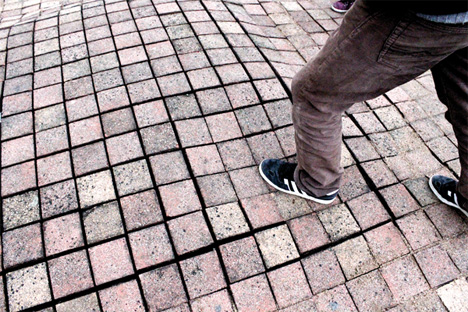
The normal urban environment is hard, angular and not often playful. We go about our business with the type of calculated indifference cultivated through years of city dwelling. But when that cold, hard environment suddenly changes unexpectedly, we have no choice but to snap out of our collective reverie and take notice. That is precisely what happened when residents of Bourges, France came upon a highly unusual section of sidewalk.

This urban art installation was created by the Raum in the Box residence at the National Superior School of Art in Bourges. From a distance (and ignoring the small spigot at the top) this bump in the bricks looks almost like a speed bump. But when pedestrians stepped on it, it gave way and began to ripple and sway.
The “bricks” hid a soft water-filled cushion that provided an unusual way to interact with the city landscape. Children, adults and even pets were enchanted by the feeling of a fluid surface beneath their feet.
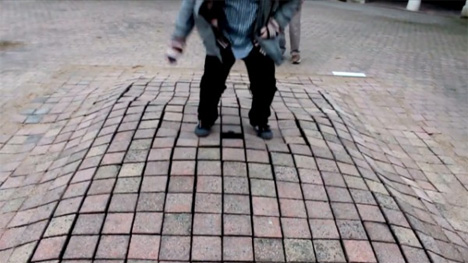
As an unexpected and non-threatening piece of urban art, La Ville Molle is an amusing and charming success. It flips our perceptions of the city on their heads and lets pedestrians interact with their town in a way that has never before been possible. But even more strikingly, it provides for a moment of play: something that is definitely lacking in most of our daily adult lives.

Did You Know™ that the dormouse sleep three quarters of the year in a nest? (That’s insta-dorabuhls). They weigh 15 to 30 grams, and they’re English, so you know when they talk, it’s absolutely charming.
![[Tiny honk-shu sounds] Mhd002sleepingdormice](http://cuteoverload.files.wordpress.com/mhd002sleepingdormice-4262-1-_tplq.jpg?w=500&h=375)

First still image by Terry Whitaker, Dormice photographer extraordinaire. Second photo from Smart Images UK. ![]()

If trees could play music, what would it sound like? That may seem like a silly question, but artist Bartholomäus Traubeck has found a way to answer it. The appropriately titled ‘Years’ project translates the rings of tree slices into piano music using a vintage turntable, a Playstation Eye Camera and a computer running the software ‘Ableton Live‘.

YEARS from Bartholomäus Traubeck on Vimeo.
The effect, as you can hear in the video above, is surprisingly somber and haunting. The German-born artist, who divides his time between Rotterdam, Netherlands and Linz, Austria, explains that the music software reads the rings as they shift and change and translates that raw sound into a pre-selected musical sound – in this case, piano.


“A tree’s year rings are analysed for their strength, thickness and rate of growth. This data serves as basis for a generative process that outputs piano music. It is mapped to a scale which is again defined by the overall appearance of the wood (ranging from dark to light and from strong texture to light texture). The foundation for the music is certainly found in the defined ruleset of programming and hardware setup, but the data acquired from every tree interprets this ruleset very differently.”
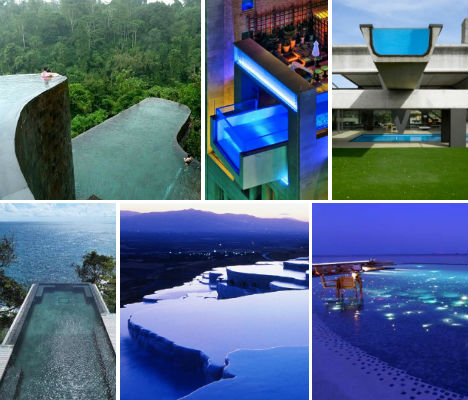
The edges of these pools seem to just drop off into space, threatening to whisk swimmers off a cliff, into the sea or over the edge of a skyscraper. Infinity pools, also known as zero-edge pools, use glass walls or waterfall-like overspill troughs to achieve this sometimes vertigo-inducing effect. These 15 particularly scenic infinity pools will have you daydreaming about booking summer vacations.
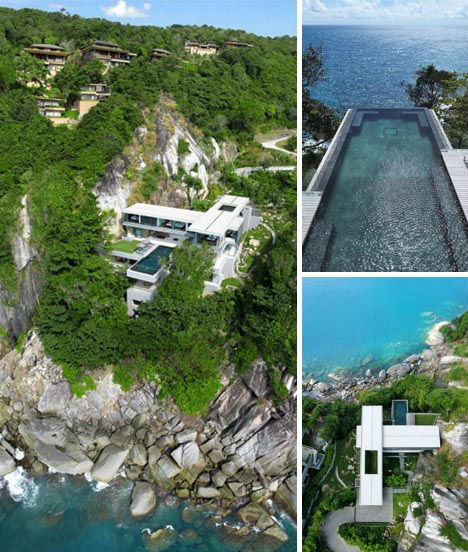
Talk about dream houses – this jaw-dropping ultramodern residence in Thailand not only perches on the edge of a cliff overlooking the ocean, it’s got a shimmering cantilevered infinity pool that seems like it extends out forever into the sea. Designed by Original Vision, the home features stacked levels that lift the living spaces high above the tree level, providing the best views possible.

Swimming pools don’t get much more scenic than this. The Ubud Hanging Gardens Hotel in Bali has a towering, multi-leveled infinity pool that looks like a natural cliffside and was in fact designed to mimic the surrounding hills. In addition to the two main pools, each of the 38 guest rooms at Ubud has its own mini infinity pool with views of the nearby Pura Penataran Dalem Segara temple.

With views of both the sea and the city of Mumbai and a stunning wrap-around rooftop-deck infinity pool, this unusual geometric house design has it all. While the exterior of the house is a bit eclectic to say the least, the pool more than makes up for it. Lifting the pool above ground level must give the sense of swimming in the sky, especially given the house’s location on top of a hill.

Another tempting resort with an infinity pool for each room is Jade Mountain in St. Lucia, where the views are almost too gorgeous to be believed. The pools are referred to as ‘sanctuaries’ and are classified as ‘stars’, ‘moons’, ‘suns’ and ‘galaxies’ according to size. A night experiencing one of these pools for yourself will range between $950 and $2,700.

A private modern residence in Phuket, Thailand, Villa Mayavee has a beautiful slatted wood exterior and lots of glass for looking out at those enviable views of the ocean, but more importantly, check out that pool! Situated between floors, the large infinity pool seems to spill out of the house itself.

Renowned for its spectacular rocky cliffs overlooking the sparkling Mediterranean Sea, Italy’s Amalfi Coast is one of the most beautiful places in the world. At Hotel Caruso in Ravello, guests can enjoy these views from a heated infinity pool on a clifftop 1,000 feet above sea level. The modern pool is a stunning contrast beside the historic 11th century hotel, a former palazzo.

What better way to contemplate the natural beauty of Santorini than from a sparkling pool with cliffside views? The Greek island’s Astarte Suites mimics the blue of the ocean and the rocky landscape with its pools and stone pillars.

One of Thailand’s prettiest pools is at Langham Place Miora Resort & Spa, located in Phuket. Overlooking the ocean as these resorts typically do, the pool wraps around the exterior of the resort – on the second floor. Each of the 78 designer villas also has its own private plunge pool with retractible floating dining tables.

Studded with submerged lights and extending out right over a private lagoon in the Indian Ocean, the Huvafen Fushi Resort’s zero-edge pool is a fantasy swimming experience. Just like many of these other high-dollar resorts, Huvafen Fushi’s 43 private bungalows each have their own smaller pool, as well. The resort also has an incredible underwater spa with glass walls that give relaxed patrons dreamy views of passing marine life.

Few homeowners can boast not only of a conventional in-ground swimming pool, but also a rooftop infinity pool that cantilevers out over the grass. Hemeroscopium House by Ensamble Studios is a prefabricated concrete house built from three huge I-beams, two segments of an irrigation canal and two steel girders for a highly unusual look. It took just a week to assemble.
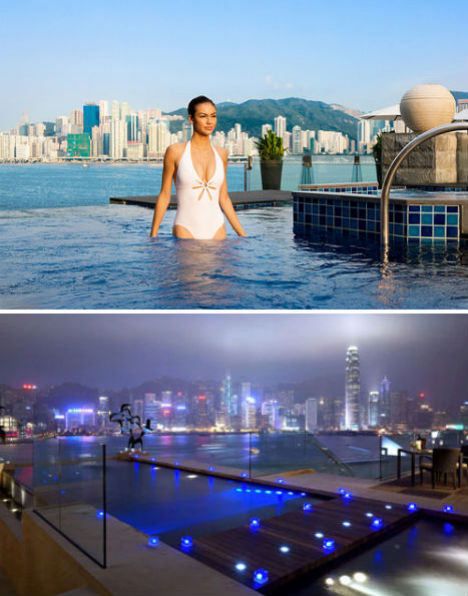
And now for something completely different: an infinity pool that overlooks not some tropical paradise, but the bustling urban metropolis of Hong Kong – from a third-floor deck. This glass-walled pool still has the feel of a luxury vacation, of course, not just because of the pool itself and the hotel’s many amenities but because of the stretch of water that separates the hotel from the city.

Swim out to the glass end wall of the cantilevered rooftop pool at the 10-story Hotel Joule and you’ll feel like you’re about to spill out into the streets of downtown Dallas, Texas. The pool juts out eight feet beyond the exterior walls of the hotel, enhancing the experience.

The sound of waves hitting the sand? Check. The sound of a waterfall just below you, as the infinity pool you’re relaxing in spills over into a decorative fountain basin? Check. All the incredible sights of tropical Tahiti? Check, check, check. If you’re lucky enough to stay in a place like this, even for a night, you’re lucky enough.

From WebEcoist: “When most people envision a pool with an incredibly scenic view, they most likely think of tropical beaches, not skyscrapers – yet there’s no denying that the scenery at the Marina Bay Sands Hotel pool is absolutely breathtaking. Not only is this nearly 500-foot-long pool set into a rooftop skypark, 679 feet above the ground, but it’s an infinity pool, giving swimmers the feeling that they could swim right off the edge of the building. The pool looks out onto one of the world’s most modern cities, which is brilliantly illuminated once the sun goes down.”

As if man-made infinity pools weren’t cool enough, there are also natural edgeless pools that will take your breath away with their beauty. Perhaps the most stunning example is the cliffside hot springs of Pamukkale, Turkey, where falling mineral water rich in calcium has carved basins and stalactites into the rock and turned the entire area snow-white. Visitors are no longer allowed to swim in the pools, as the site is now a protected UNESCO World Heritage Site.


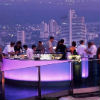




Art is sort of a peaceful Switzerland where people from all walks of life can come together. And I think this Switzerland of sorts is why Sergey Brin, who is also quite an enthusiastic photographer, joined the hangout last night. We had a great time talking with Sergey and Gordon Laing, Thomas Hawk, Karen Hutton, Kelli-Seeger Kim, and Chee Chew.
Watch YouTube.com/stuckincustoms for the video when it comes online! You may have to click on “Uploads” to see the most recent things. I have a number of playlists on there too.
The new Google offices in Los Angeles are right in the heart of Venice. After passing through some hardcore security, you walk down this hallway, which I guess is a bit like dying and going to Google heaven.
You probably know about all the various Google doodles that decorate the home page. I heard the first one was of Burning Man. I didn’t see that one on the walls… but maybe you can!

Look at the back of your iPhone, or your iPad, or on the bottom of your Mac. You'll see the following words embossed somewhere: "Designed by Apple in California. Assembled in China." Many Americans, all the way up to the President himself, have wondered why Apple has outsourced virtually all of its manufacturing overseas. At a dinner with several top US technology executives last year, President Obama asked Steve Jobs flat out what it would take to bring those jobs back to the US. According to Jobs, there's simply no way for it to happen.
Why not? Why can't iPhones, iPads, and all the rest of Apple's magic gadgets be built in the States? More generally, why can't more US-based consumer electronics and computer companies do their manufacturing work domestically, helping to create American jobs and boost the struggling economy?
The New York Times asked that question, and after an extremely well-researched report involving interviews with both former and current executives at Apple, the answer the Times found is both simple and chilling: iPhones aren't made in America because they just can't be. The infrastructure and labor force doesn't exist at the levels necessary to support Apple's operations -- it's not even close.
The Chinese factory where most iPhones reach final assembly employs 230,000 workers. I just asked Siri how many cities in the US have a population higher than that, and the answer was a mere 83 cities -- and that's total population, not workforce. With an average labor force of around 65 percent of the population, only 50 US cities are large enough to provide that kind of labor pool... and even in the biggest US city of them all, New York, 230,000 people still amounts to almost three percent of the city's entire population. Can you imagine three out of every hundred New Yorkers on an assembly line, cranking out iPhones every day?
Over the past couple of years, we have heard a great deal concerning working conditions at factories owned by Foxconn. The Chinese manufacturing company is responsible for assembling consumer electronics for most of the major vendors out there, including Apple. Around a fourth of those 230,000 people live in company-owned dorms or barracks right on factory property; that's almost 60,000 people living and working at the factory. Many of the people at "Foxconn City" work six days a week, twelve hours a day, and they earn less than US$17 per day. It may sound inhumane by American standards, but these jobs are in high demand in China -- so much so that Jennifer Rigoni, former worldwide supply demand manager for Apple, told the New York Times that Foxconn "could hire 3,000 people overnight."
Those are just a couple examples of how the scale, speed, and efficiency of Chinese manufacturing outstrips anything the US is currently capable of. But the Times' report is full of more evidence, and it's damning. Even though the 200,000 assembly-line workers putting part A into slot B could potentially be classified as unskilled labor, the 8700 industrial engineers overseeing the process can't be -- and according to the Times, finding that many qualified engineers in the States would take nine months. Chinese manufacturers found them all in 15 days.
With the notable exception of the A5 processor, most of the components used to make the iPhone are also manufactured overseas, many of them within a relatively short distance of the final assembly plant. Shipping those components to any potential US-based factories would incur greater costs, and even worse from Apple's perspective, manufacturing delays.
Traditional defenses of outsourcing of manufacturing jobs have revolved around cost. "It costs more money to build in America," the reasoning goes; "You have to pay your workers more, you have to pay benefits, insurance, higher taxes. Everything costs more." Since companies want to make a profit, that added cost inevitably gets passed on to the consumer in inflated prices for goods.
To exaggerate the point, many have claimed that an American-manufactured iPhone would cost thousands of dollars. It turns out that's hyperbole; according to the New York Times, the increased cost of paying American wages to workers would add $65 to the cost of an iPhone. The other costs, added together, probably wouldn't drive the unsubsidized price of a 16 GB iPhone 4S over US$1000. But the dollar cost of manufacturing in America isn't the biggest issue that's driving Apple's decision to outsource manufacturing to China. Instead, it's about who can build the greatest number of iPhones within the shortest period of time, all while remaining flexible and instantaneously adaptable to Apple's needs. According to one current Apple executive, "The US has stopped producing people with the skills we need."
The Times provides a telling example from the early days of the iPhone, before it ever hit the market. It's hard to believe now, but originally the iPhone's screen was going to be made from the same scratch-prone plastic that graced the fronts of its contemporaneous iPod models. In mid-2007, just over a month before the iPhone was scheduled to hit stores for the first time ever, Jobs realized the folly of using that plastic when the screen of the iPhone prototype he was carrying in his jeans pocket had accumulated dozens of scratches. "I won't sell a product that gets scratched. I want a glass screen, and I want it perfect in six weeks."
Anyone who knows how Jobs worked knows that he wasn't bluffing -- if the iPhone didn't meet his standards, it wouldn't go on sale, period. Six months of anticipation had driven demand for the first iPhone into a frenzy, so Apple knew it was going to have to crank them out as quickly as possible. But the last-second change to what was arguably one of the iPhone's most central components meant initiating the kind of mad scramble that simply wouldn't be possible in US manufacturing. Apple would have been an industry laughingstock for as long as it took to overcome the manufacturing delay. Instead, what might have taken months to transpire in the US took place in six short weeks; Apple sourced a virtually scratchproof glass from Corning, and Chinese factories rapidly managed to integrate it into the existing iPhone design.
As it's an American company reaping unprecedented financial rewards, many Americans have lamented the fact that the rewards coming back into America are so comparatively meager. Apple employs 43,000 people in the United States, less than a fifth the number of contractor employees assembling iPhones at one Chinese factory. One could argue that Apple's success has come at the expense of the American manufacturing workforce, but if the New York Times' report is anything to go by, it seems the workforce Apple would have needed in America never existed to begin with.
Why Apple's products are 'Designed in California' but 'Assembled in China' originally appeared on TUAW - The Unofficial Apple Weblog on Sun, 22 Jan 2012 10:00:00 EST. Please see our terms for use of feeds.
Continue reading Human Birdwings project takes flight... on video!
Human Birdwings project takes flight... on video! originally appeared on Engadget on Fri, 20 Jan 2012 10:31:00 EDT. Please see our terms for use of feeds.
Permalink | Human Birdwings | Email this | Comments
Human Birdwings | Email this | Comments